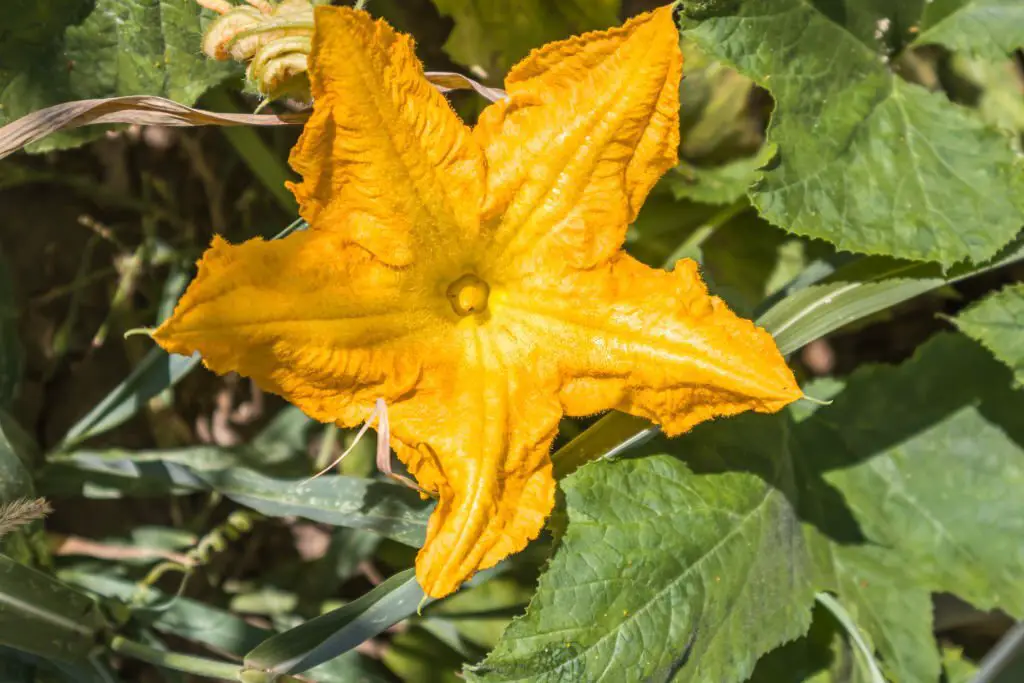Last Updated on April 9, 2024 by Real Men Sow
Pollinating female pumpkin blossoms are very similar to pollinating squash blossoms. Both can be successfully grown the same way too.
If you see a female pumpkin blossom that you wish to hand pollinate, it is important to keep an eye on it as it grows. I will pollinate all female flowers on secondary vines that extend from the main vine. This is to protect the best one in case of an emergency. After I am certain which pumpkin is growing fastest, I will cut down the rest. Each plant that I take care of will have two giant pumpkins. The backup.
Pumpkin Blossoms Are Male or Female
The pumpkin blossoms can either be male or female. Both the male and female pumpkin blossoms produce pollen as well as nectar. The female blossoms only produce nectar.
As a natural process of nature, pollinating insects travel through your pumpkin patch to visit the male and female blossoms and bring pollen along. The pollen remains in the female flower and fertilizes it with heavy, sticky pumpkin pollen.
This is why it is important to recognize whether pollination occurred by knowing how to identify male and female flowers.
Identifying Blossoms as Male or Female
The male blossoms open first, approximately a week earlier than the females. This is a clue to identifying pumpkin blossoms. This is a good strategy because it keeps the vines “on the radar” for local insects for several days before their time. Like other flowers, male blossoms grow on a thick, straight stem. Female blossoms, however, have a shorter, more compact stem that has a small bulge at its base. If the blossom is pollinated, this is the ovary.
You can see the pollen-coated central anther of male blossoms by peeling back their petals. It looks like a miniature version of a cattail’s brown brush. The stigmas on the female blossoms are small and must be pollinated by the male blossom in order to fertilize the pumpkin. You can search online for photos of male and female pumpkin flowers if you are a visual learner.
Look for Pollen and Pollinators
The pumpkin blossoms open in the early morning so it’s best to check them while you still enjoy your first cup of coffee. You should be on the lookout for honeybees, squash bees, and bumblebees visiting the blossoms. All of them are effective pollinators. Visually inspect the female blooms for pollen stuck to their stigmas. Also, check for the growth of the pumpkin buds once the blossoms are shriveled.
Your yields will increase if you encourage healthy populations of bees. You can provide other sources of pollen early in the season before the squash blossoms or pumpkins, and you should avoid using systemic pesticides that kill both bees and pests. Bumblebees and native squash bees hibernate in the soil in cold weather. They build their nests in those areas in season so don’t plant or till too much in your pumpkin patch.
Hand-Pollinating Female Pumpkin Blossoms
Do it yourself to verify that your blooms have been pollinated. When the blossoms are still open in the morning, remove a male bloom from the vine. Then, take out the petals and reveal the anther. This can be used as a paintbrush to apply pollen to several female blossoms. Then, use the same technique with a different flower. You don’t have to cut off the male blossoms. Instead, use a paintbrush and a cotton swab.
This process can be repeated for several days. The male pollen is used to pollinate the female blossoms. As a result, you should see a good fruit set.
Problems You May Encounter
There are a few things that could cause problems in the growth of your pumpkins. For example, your female pumpkin flowers may not open, or your pumpkin might stop producing fruit.
High daytime temperatures can cause a pumpkin bud to not open into a male blossom. Too much nitrogen, which encourages vine growth but slows blossom development, can also lead to a problem. Consider giving plants shade to protect them from the heat of the afternoon if you discover unopened buds in their foliage.
In an effort to survive, plants that are stressed by high nighttime temperatures, drought, or other factors might stop producing fruit. It is important to water your plants regularly and reduce competition from weeds. If the fruit isn’t pollinated properly, they may abort or fall off. However, hand-pollinating will ensure that this doesn’t happen.

